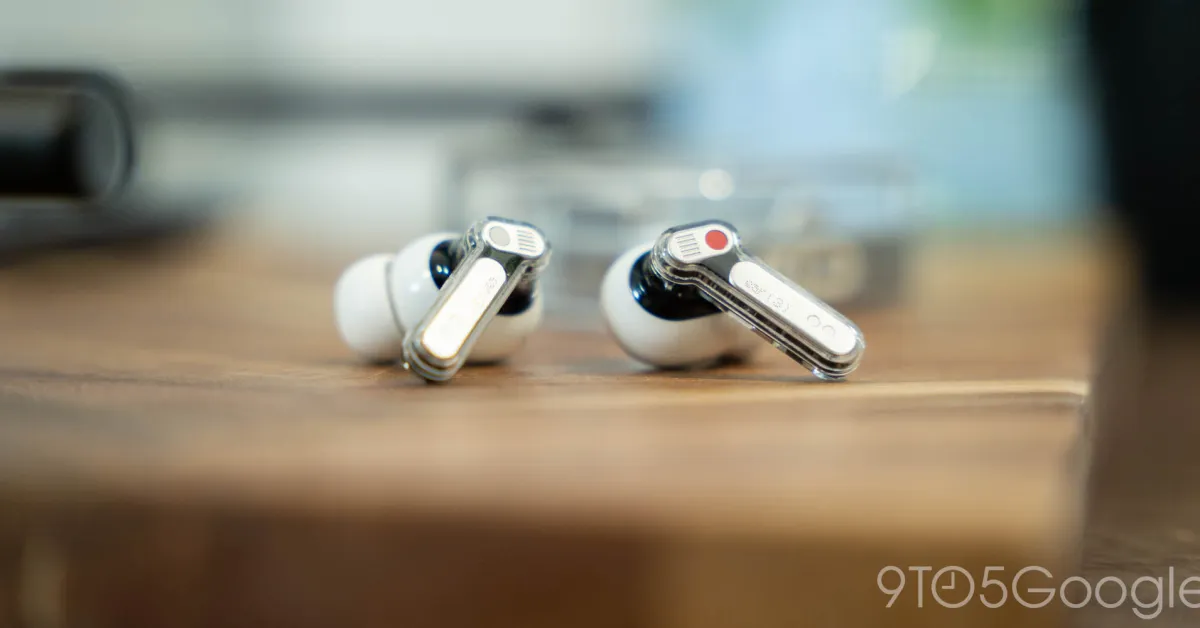
Nothing gets a lot of attention around its smartphones nowadays, but audio products are what made a name for the company. Over the past week, I’ve had the chance to check out the Nothing Ear (3), the fourth-generation earbuds from Nothing, and I’ve got mixed feelings.
Nothing Ear (3) arrive as a successor to last year’s Nothing Ear which, if you caught any of our coverage, means these have big shoes to fill. Nothing Ear balanced stellar sound quality, useful features, and an affordable price perhaps better than any other earbuds on the market. It’s a lot to live up to for a successor, especially when the path forward isn’t exactly obvious.
Review: Nothing Ear, Ear (a), and Ear (open) hit all the right notes in all the right places
In many ways, Nothing Ear (3) follows the blueprint established by the past few generations.
The hardware design is essentially identical. The case is still a little bulky, but the change to a metal bottom half is appreciated. Over the past year, my Nothing Ear’s case has picked up tons of scrapes and scuffs. I’m not convinced that the plastic top half of this latest case will be any different in that regard, but I’m hoping the bottom half will fare a bit better with time.
Advertisement – scroll for more content
The earbuds themselves feel the same as prior generations, though the very minimal cut to thickness in the stems does lead to a slightly more comfortable wear. Battery life is also still about the same. Nothing claims 5.5 hours of battery in the earbuds themselves with ANC turned on, and 22 hours in the case, which roughly lines up with the testing I’ve done thus far. The ANC is still underwhelming, as was the case in the past, but I will say that the transparency mode is excellent. It feels more natural than any others I’ve tried in recent memory.
But, what’s actually new this year? Mainly two things.
Firstly, there’s the sound quality.
Nothing Ear (3) have a new sound profile that you’ll either love or hate. Where Nothing Ear had a very neutral sound profile, Ear (3) is extremely rich, for better or worse. This primarily comes from the low ends, where bass is noticeably heavy even with any enhancement settings disabled. The “Balanced” EQ has noticeable “booms” in some songs. It’s a quality that, even with enhancements, wasn’t easy to replicate in last year’s release. So if you like those low-ends, it’s great news. However, it does tend to feel overwhelming at times. Certain songs just have too much punch under this new profile, and ironically, it’s pretty hard to get rid of that. Even if you use the custom EQ to minimize low-ends as much as possible, there’s still a noticeably strong punch in certain songs. Using the “basic” custom EQ, dropping the bass to -3 or lower while boosting the mid and treble to your own tastes brings some welcome balance to the sound profile, at least in my opinion.
But the beauty of the Nothing X app is that you have a lot of control over the sound through the basic and advanced EQ settings. You can’t change the underlying tendencies of the sound profile that favors low-ends at the expense of high-end clarity, but you can tweak it pretty heavily to match your tastes.
I’m not really surprised to see changes to the sound here. While Nothing received plenty of praise for the sound quality on its last generation, Nothing Headphone (1) was the first to move away from that neutral profile, again with one that favored the low end.
And, really, that’s just because most people enjoy that sort of sound.
I think that anyone who tries out Nothing Ear (3) will be largely satisfied. The audio quality is no longer tuned for audiophiles, but just to be a crowd pleaser. If that was the goal, I think Nothing accomplished it, more or less.
Beyond the sound, though, there’s also the new “Super Mic” feature which has a microphone built into the case.
When I first heard about this feature, I thought it sounded like a cool idea. But, in reality, it’s just a massive missed opportunity.
The idea behind “Super Mic” is that it’s a better microphone on the case that you can use in place of the microphone in the earbuds themselves. So, if you’re on a call, you can press the “Talk” button on the case and then use that microphone to get higher-quality audio and, more than that, to improve the noise cancellation of sounds in your environment.
I think it’s completely pointless.
To make this work, you need to be wearing at least one earbud and then be holding the case up to your mouth, all while being on a call. Again, the idea is to improve the audio quality, but what’s the point when you could… just use the phone??
When not in a call, the “Talk” button can be used to launch your preferred voice assistant, such as Gemini, but it can’t do that without turning on the phone’s display – and yes, this happens by accident frequently while the case is in my pocket with other things next to it. So, again, I don’t see the point, especially as you’ve got the earbud in already. The other trick is exclusive to Nothing Phones, with a press and hold on the “Talk” button sending voice notes to the Essential Space app. That’s perhaps the best selling point I’ve heard but, again, why not just use the phone itself? You’re already pulling something out of your pocket, and something that literally has its own dedicated button for Essential Space notes, so why not use the phone instead? There is a “Walkie Talkie” mode that mutes all of the mics unless you’re holding the button, which is a nice idea for privacy at least.
Beyond the functional questions, Super Mic just… doesn’t seem to work, at least in the places I’ve tried it.
I tested the feature with our Andrew Romero in a call, and immediately ran into a problem that it doesn’t work with Google Voice. That’s probably fine since most people don’t use Voice in the first place, but it highlights the compatibility woes here. To get some proper testing in, we jumped over to Google Meet, and it was… not great. Firstly, the difference in audio quality is negligible. Andrew said I sounded louder, but there was not really a discernible difference in quality – at least in our call. That’s not great when the point of comparison is, you know, a pair of earbuds. To test out the noise cancellation, I put loud music on in the background. The earbuds did a great job filtering this out. When I was speaking, Andrew couldn’t hear the music at all despite the speaker being on full blast just a few feet from me. When I switched over to Super Mic, he said he could hear the music while I was speaking. With Nothing’s pitch being that Super Mic is better at cancelling out nearby sounds, this example seems to show that it needs some work. I’m sure this works better in other situations – a bustling city street or a store would be places I’d expect it to work better – and can be tuned in time but, as it stands today, I’m certainly not impressed.
Again, though, I just don’t even see why this exists in the first place, even if it did work as promised.
Where Super Mic could have come in handy, in my book, is if it worked as a remote mic for video. Holding a microphone while recording videos has become a trend lately, and having that built into your earbud case would be awesome! Except it doesn’t work with camera apps. Unless you’re using a third-party camera app like Blackmagic, the Talk button just summons your voice assistant. I confirmed this across Pixel, Samsung Galaxy, iPhone, and even the Nothing Phone (3). You cannot use it to record a video, which seems like a giant oversight.
And, again, it only works if you have an earbud in.
The other thing I would have really liked is if the case could be used to access a voice assistant like Gemini on its own. So, no earbud in my ear, no phone screen turning on, just a press of the “Talk” button to summon Gemini and then have a small speaker on the case pipe through the response. That would have been fun at bare minimum, and maybe even useful.
Super Mic was probably built with great intentions, but I think its limitations take away most of the value. If anything I suspect that Nothing originally wanted to do a lot more with this, but ran into walls they couldn’t overcome during development. At a certain point, any brand has to make concessions, but I think the final product here just didn’t live up to the initial vision.
The main takeaway I’ve had around Nothing Ear (3) thus far is that, while they’re the “latest and greatest,” I don’t think they’re meaningfully better than the prior generation. The sound is good in my book, but it’d be hard to make a major upgrade over Nothing Ear’s baseline. The core feature set is essentially identical too. And “Super Mic,” while a neat idea, is absolutely not a good reason to buy these over their predecessors.
If it were me, I’d just buy last year’s Nothing Ear while they’re still available, especially as you can often find them at a discount. Retailers such as Amazon still have stock available, though I’m sure that will dry up in the weeks to come.
That said, I don’t think anyone will be disappointed in Nothing Ear (3). Just because the opportunity to try something new fell flat doesn’t mean that the rest of the product is ruined. I’ll be switching to these from my Nothing Ear going forward, largely because I like the updated case and, over my time using them, the sound profile has really grown on me.
Nothing Ear (3) is available for pre-order now for $179, with general availability on September 25. Are you interested?
Where to buy Nothing Ear (3)
Nothing
Amazon
More on Nothing:



